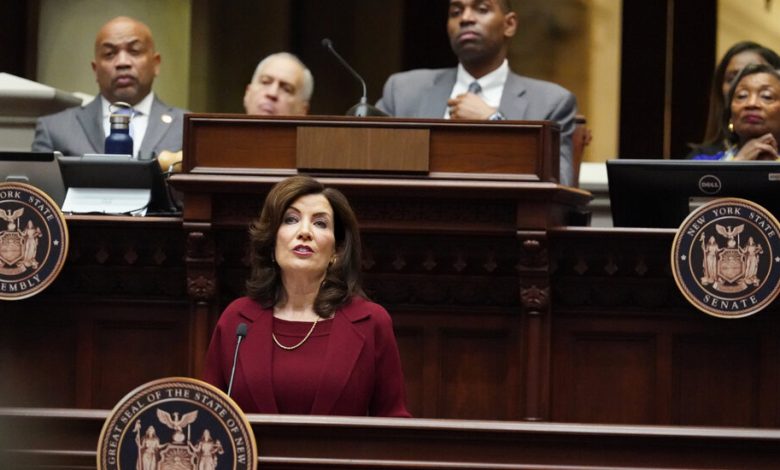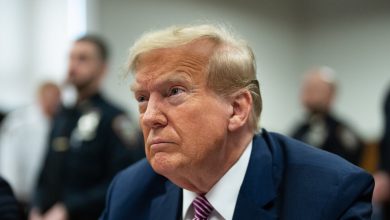N.Y. Reconsiders Capitol Artworks That Offend Native Americans

At an informal gathering last summer at the Executive Mansion in Albany, N.Y., Gov. Kathy Hochul shared an anecdote about making an unpleasant discovery there, not long after taking residence: a painting depicting the marriage of Pocahontas.
The governor thought Pocahontas looked young and frightened, and had the painting removed. In its place went what she considered to be a more tasteful portrayal of Native people in Niagara Falls.
But surely she was aware of a far more inflammatory display of art, just outside her executive office in the State Capitol: a century-old mural showing the French explorer Samuel Champlain victorious in combat with an accompanying caption, “Champlain Killing First Indian.”
No, Ms. Hochul replied. She and her top lawyer, Liz Fine, said they were unfamiliar with that artwork in the governor’s reception room, also known as the War Room for its many battle depictions. Ms. Fine said the matter would be looked into.
Last week, the governor formalized the inquiry. In her list of policy proposals in her annual State of the State message, Ms. Hochul vowed to conduct a comprehensive review of all the “artistic representation of Indigenous peoples in the Capitol” and come up with a plan, yet to be fully defined, to deal with it.
“The New York State Capitol is for the people,” Ms. Hochul said in a written statement. “All should feel welcome in its hallowed halls.”
The push to reconsider the paintings comes amid a broader era of reconsideration of — and, often, reconciliation with — American treatment of nonwhite people.
In the racial upheaval that followed the killing of George Floyd by police officers, various institutions confronted questions about statues glorifying Confederate leaders and bloodthirsty explorers.
The upstate New York village of Whitesboro made national news in 2017 when it finally decided to change its seal, which showed a white man with his hands around an Indigenous man’s neck in a wrestling match. The state of Minnesota in 2023 redesigned its flag, which appeared to celebrate Native Americans being driven from their land.
Advocates have long protested artwork in the United States Capitol where Native people have been portrayed fighting, cowering, dying and dead. One sculpture, which portrayed a settler dominating an Indian, was considered so offensive in 1939 that lawmakers called for it to be “ground into dust.” Even so, it remained on display until 1958, when it was moved into storage.
In New York’s statehouse, the face of Christopher Columbus, reviled by many Native Americans for his brutality toward their ancestors, is etched into the red sandstone of the Million Dollar Staircase.
And on the east side of the Capitol stands a statue of a U.S. Army general, Philip Sheridan, who racked up a record of barbarism against tribes west of the Mississippi and is widely credited with coining the phrase, “the only good Indian is a dead Indian.”
“Unfortunately, offensive imagery and distasteful representations of populations in the art which adorns the Capitol can alienate visitors,” Ms. Hochul’s staff wrote in the 2024 State of the State briefing book.
The report noted that Native people in particular are often depicted in a way that “reflects harmful racial stereotypes and glorifies violence against Indigenous peoples.”
The brief policy blurb does not specifically mention the War Room, but examples there are among the most troubling.
Champlain is shown engaged in hand-to-hand combat with a muscular, unnamed Native. In 1609, Champlain and a party of Native people he was traveling with came upon a group belonging to the Haudenosaunee confederacy — also known as Iroquois, a term some now consider offensive — near the area that is now Fort Ticonderoga.
A fight ensued, and Champlain killed two of the group’s chiefs, setting off a larger war between the confederacy and the French.
“They had guns. They came across a hunting party. They shot them,” said Oren Lyons, a Faithkeeper with the Onondaga nation, part of the same Haudenosaunee confederacy. “Our people had bows and arrows.”
The portrayal of Native people — like the fearsome warrior on the ceiling of the War Room — was not simply an inaccuracy that could be relegated to the past, Mr. Lyons said.
“They always call the Haudenosaunee — the Iroquois — fierce, fierce warriors and fierce fighters — and our mission is always been peace,” he said. This image had a purpose then and it has a purpose now, he said, adding: “To put it put it quite bluntly, you really can’t take land from a good guy.”
Ms. Hochul, like Gov. Andrew Cuomo before her, has had a rocky relationship with Native groups. She clashed with the Seneca Nation in Western New York over disputed gambling revenue that she eventually used to pay for the Buffalo Bills’ new stadium.
Several vetoes of pro-Native bills, including one a few weeks ago that cited racist court rulings from the early 1900s as part of the justification for denying state recognition of the Montaukett Indian Nation of Long Island, have also riled Native groups and their legislative backers.
But Ms. Hochul also signed sweeping protections for ancient Native graves into law last year and elevated Native issues in her own office with the appointment of Elizabeth Rule, an enrolled member of the Chickasaw Nation, as deputy secretary for First Nations. Ms. Hochul also became the first governor in at least 50 years to visit the Onondaga Nation home territory.
Besides confronting the offensive art, Ms. Hochul is promising this year to improve access and funding for dental care for Indigenous people and to correct historical injustices inflicted on Native children, including at boarding schools in New York, by advancing strategies to strengthen the objectives of the federal Indian Child Welfare Act.
“Since taking office, I’ve worked to strengthen nation-to-nation ties between the state of New York and Indigenous peoples, and will continue these efforts for years to come,” Ms. Hochul said.
Ms. Hochul’s policy initiative includes plans to invite representatives of the nine recognized tribes in New York to provide input and advice, though the governor would make the final call on what to do with any offensive art.
A spokesman said possible remedies include providing supplemental materials such as brochures or placards that would help contextualize existing artwork, as well as adding Indigenous art work to spaces inside the Capitol.
Nowhere does the proposal mention the possible removal of paintings or statues. Still, at least one New York tribal chief, Harry Wallace of the Unkechaug Nation on Long Island, favors getting rid of it.
“I think it should be removed,” he said. “This is just a slap in the face.”
Robert Odawi Porter, a former president of the Seneca Nation of Indians, said he would rather keep the mural and use it as a “teaching moment” by including some sort of explanation for Capitol visitors. He recalled the many times he waited in the hall outside the governor’s office to discuss often contentious issues between the state and his tribe.
He said the mural energized him to more fiercely advocate for his people, who belong to the same confederacy as the one that is most likely depicted in the painting.
“It would always be motivational because I said this is the only true thing in the building,” Mr. Porter said. “It’s how they feel about us.”



